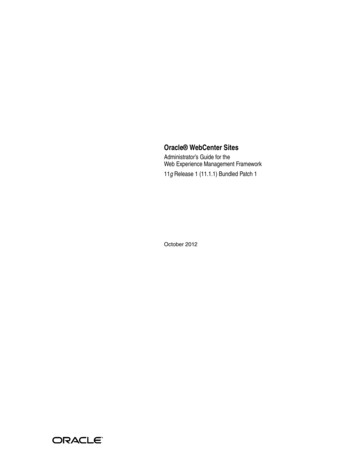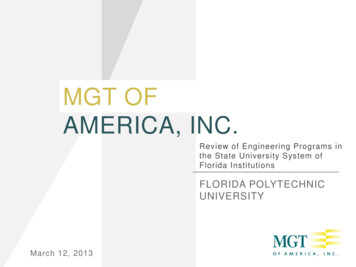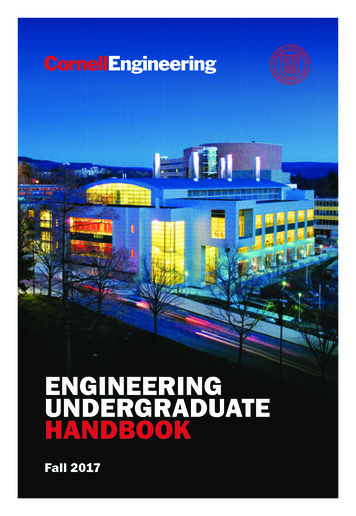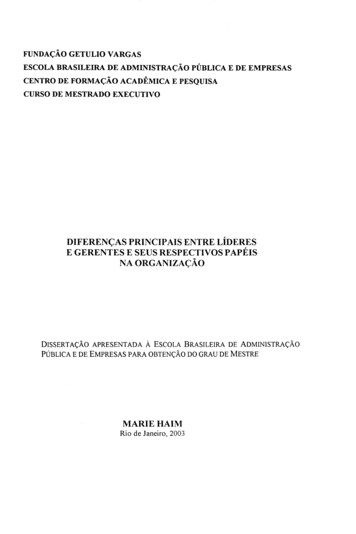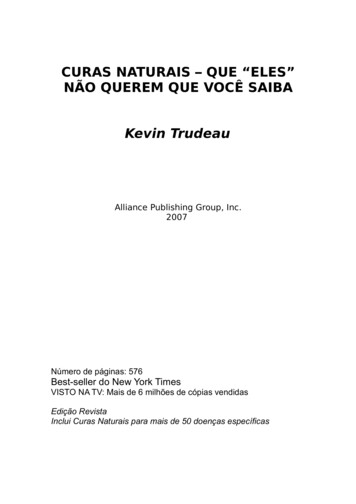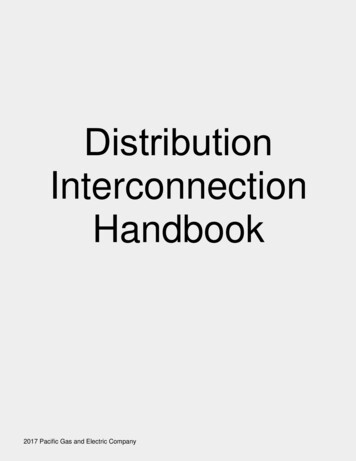
Transcription
NEMEngineeringFrameworkInitial RoadmapDecember 2021
Executive SummaryExceptional change is required to enable the National Electricity Market (NEM) to securely and efficiently transition to new operationalconditions. The instantaneous penetration of renewables is increasing rapidly and, with appropriate preparation, could reach up to100% at times by 2025. Urgent and extensive industry collaboration and effort is needed to engineer the power system to meet thesenew conditions in a timely and orderly manner, with positive consumer outcomes at the heart of all decision-making.This Initial Roadmap summarises the breadth of potential efforts and decisions needed to prepare the NEM power system for thefutures envisioned in the Integrated System Plan (ISP). It represents a further step in the ongoing collaborative development of theEngineering Framework with stakeholders, and provides the foundation for engagement in early 2022 where organisations need todecide on the priorities of greatest value for them to lead or contribute towards.This report is presented using an interactive format. To navigatethrough this document:The purpose of this Initial Roadmap document is to: Stimulate open and transparent collaboration with stakeholders on the actions required tooperate the NEM under future Operational Conditions1.Click here to return to the contents page. Summarise the outcomes, insights, and potential priorities from the recent gap identificationprocess undertaken in collaboration with stakeholders.Click on the navigation pane at the bottom of each page to navigateto any part of the publication. Highlight key strategic decisions required in the near term to enable a secure and efficienttransition to the six identified future Operational Conditions1.LinkClick on teal underlined text to go to another resource or jump to alinked part of this report. Some graphics also include links. An indexof links is provided at the end of this report. Numbers like this25 referto the index of links.Headings in theSummary ofpotential gapsOn the Summary of potential gaps pages (17-19), clicking on a columnheading will take you to the full list of potential gaps for that headingin the Appendix. Highlight the need to come together as an industry in 2022 to determine how our respectiveorganisational efforts can be most valuably applied to determine priority gaps and priorityactions.Important notice:This document is subject to an important disclaimer that limits and excludes AEMO’s liability for reliance on the information in it. Please read this (on page 24) before you read the rest of this document.1Context2Frameworkoverview3Roadmap4Next steps5Appendix ofpotential gaps6Acronyms and links2
Table of contentsContext4Framework overview9Roadmap13Elements of the Roadmap14Key decisions on approach for near-term actions15Grouping and summarising potential gaps16Summary of potential gaps – Attributes17Summary of potential gaps – Operability18Summary of potential gaps – Integration19Next steps20Appendix of potential gaps25Acronyms and links481Context2Frameworkoverview3Roadmap4Next steps5Appendix ofpotential gaps6Acronyms and links3
Context1Context2Frameworkoverview3Roadmap4Next steps5Appendix ofpotential gaps6Acronyms and links4
A rapid energy transitionThe NEM is undergoing profound transformation of an unprecedented scale and pace.It will rapidly cross uncharted operational conditions yet to be experienced here or incomparable power systems internationally.Figure 1: Historical and projected NEM maximum, average, and minimum instantaneous renewable* penetration100%Figure 1 shows the rapid growth in maximum instantaneous renewable energypenetration in the NEM, doubling over the last three years and reaching a record of 61.8%on 15 November 2021, with some regions experiencing higher penetrations. This growth isprojected to continue with NEM-wide penetrations potentially as high as 100% at times by2025, occurring far more often by 2030.Instantaneous renewable penetration (%)90%80%The Engineering Framework examines operational conditions expected to emerge in thenext five to 10 years as a tool to guide consideration of actions necessary to enable thetransformation. These are described further in the July 2021 Operational ConditionsSummary1 and listed below, with an indication of the anticipated pace of change underAEMO’s Draft 2022 ISP2 Step Change 212022202320242025Calendar yearMinimum instantaneous penetrationHistorical linear trendlineAverage penetrationNotes:Gigawatt (GW)Gigawatt hour (GWh)Variable renewable energy (VRE)Virtual power plant (VPP)Maximum instantaneous penetrationFuture penetration based on resourcepotential in ISP Step Change trajectoryPotential constraints on renewable penetration*’Renewable’ generation defined as including grid-scale wind and solar, hydro generation, biomass, storage generation and distributed PV (DPV)1Context2Frameworkoverview3Roadmap4Next steps5Appendix ofpotential gaps6Acronyms and links5
Engineering the future power systemTransitioning to operational conditions1 expected to emerge in the next10 years will require the power system to be intentionally engineeredfor a step change in capability.Figure 2: Uplift in power system capability required as new operational conditions emergeThis Initial Roadmap highlights the scale of transformation required. Thefuture power system will need to support increasingly complex dynamics inthe transition from mainly synchronous to inverter-based resources (IBR)and balance increasing volumes of variable renewable energy (VRE). It willalso need to enable increasingly decentralised operation through theongoing uptake of distributed photovoltaics (DPV) and other distributedenergy resources (DER), and increasingly critical coupling with other sectorsthrough the electrification of industry, transport and other end uses.The path to the power system of the future will need to be carefullyengineered and intentionally designed with both today’s power system andthe ultimate end state in mind.As shown in Figure 2, today’s power system and the incremental trajectoryof reform were not designed for the disruptive transition underway.Traditional, legacy approaches will need to be maintained in the near term,but inherent structural limitations will eventually constrain the pace oftransition. Parallel to this, it is critical that designing a step change in powersystem capability starts today, due to:Adapted from Pacific Energy Institute, A Gambit for Grid 2035 – A systemic look into the disruptive dynamics underway3, April 2021, p. 231Context2Frameworkoverview3Roadmap4Next steps The extent of work and collaboration required across many areas,including technical engineering, planning, and regulatory reform. The pace of change underway and the asymmetric risk to consumers ofdisorderly, constrained and inefficient transition. The risks if timely action is not taken and system operators do not havethe tools to securely and reliably manage new operational conditions asthey emerge.5Appendix ofpotential gaps6Acronyms and links6
Recent stakeholder engagementFigure 3: Stakeholder engagement undertaken during the development of this reportStakeholder engagement is at the core of theEngineering Framework. Collaborating with a broadvariety of stakeholders to understand their views onpotential gaps in the energy transition isfoundational to determining the priority actionsrequired to reach future operational conditions1securely and efficiently.October 2021Aug – Sep 2021Figure 3 outlines the collaborative approach taken todate to develop the list of potential gaps outlined inthis Initial Roadmap. During these discussions, anumber of consistent themes were raised, as capturedon the Overarching messages page.The potential gaps identified were grouped andsummarised as shown on this page. A full list of thepotential gaps identified is in the Appendix.Targeted engagement on potential gapsStakeholder information session AEMO undertook targeted stakeholder engagement toidentify potential gaps in the energy transition as part ofdeveloping this Initial Roadmap. The engagementleveraged and built on valuable insights contributed bystakeholders during the development of the operationalconditions report1. AEMO held an open-invitation information session on22 October 2021 to provide an update to stakeholderswho had indicated a desire to be kept informed but notengage in targeted discussions. This session provided attendees with a progress updateon the gap identification process and related next steps AEMO held 18 external engagement sessions with marketparticipants, network service providers and marketbodies. The session also provided an opportunity for stakeholdersto remain informed and contribute to the workundertaken to date. This process identified over 300 unique potential gaps.1Context2FrameworkoverviewContinued collaborationAEMO will continue to collaborate with stakeholdersand encourages any interested parties to get involved.Next stepsA stakeholder Q&A forum on 3 February 2022 willprovide an opportunity for stakeholders to askquestions about the content included in this report,and explore the critical next step of collaborativeprioritisation. Please register for this session via thislink. The session slides4 are available on AEMO’s website.3Roadmap4Next steps5Appendix ofpotential gaps6Acronyms and links7
Overarching messagesThroughout the collaborative gap identification process with stakeholders, a number of common messages were identifiedFigure 4: Common overarching messages highlighted during stakeholder engagement sessionsFundamental design decisions are neededUrgent action and alignment is requiredThe NEM is a highly complex ‘system of systems’, originally designed aroundthe physics of large synchronous machinesThe NEM is changing faster than ever beforeUncertainty and variability is increasing, while technology and business modelinnovation outpaces planning and reformsA step change in the ways we produce and consume electricity is underwayDecision-makers need to urgently align on priorities, timing, and approachfor additional key transition efforts beyond work in progressIntentional decisions on power system architecture and resilience are neededto ensure a secure and efficient transitionApproaches to design, investment decisions, and construction of new assetsneed to adapt to keep pace with transitionDecisions are needed on target outcomes for customer experience andoperational risk toleranceScalable risk management approaches are neededParallel paths should be pursued to maximise optionality and flexibility whilemany unknowns existEmpower participation in the evolving energy systemFrameworks used to manage connections, planning, and operationalanalysis need to be scalable and reflect pace of changeConsumers, network service providers (NSPs), aggregators andequipment providers all play meaningful roles in the transition and shouldbe fully reflected in regulatory frameworksA holistic approach to the control mechanisms that maintain power systemphysics is neededSocial licence must be sought as a foundational element in developing twoway markets, infrastructure projects, and energy reformsEngineering margin and precision modelling need balance to achieveappropriate risk profileMore skilled engineers and analysts are needed to support the transitionand increased system complexityThere is a need for an agreed approach to testing new system conditions in acontrolled environment1Context2Frameworkoverview3Roadmap4Next steps5Appendix ofpotential gaps6Acronyms and links8
Framework overview1Context2Frameworkoverview3Roadmap4Next steps5Appendix ofpotential gaps6Acronyms and links9
The Engineering FrameworkThe Engineering Framework5 is helpingdefine the full range of operational, technicaland engineering requirements needed todeliver the futures envisaged by the ISP6. Itseeks to facilitate an orderly transition to asecure and efficient future NEM system, withpositive consumer outcomes at the heart ofall decision-making.The Engineering Framework collaboratively planstransition efforts across the NEM whilesimultaneously working toward implementation ofthese efforts through existing and new programsof work.Figure 5 shows how the Engineering Frameworksupports AEMO’s near-term reporting on thesupply outlook of system needs, and maps apathway towards the ISP scenario outcomes byfocusing on the work required throughout thenext 10 years of the energy transition. EngineeringFramework interactions with other industryprocesses are shown on the next page.This Engineering Framework Initial Roadmapdocument will inform preparation of the NEM foroperation under six identified operationalconditions1, including operation with 100%instantaneous penetration of renewable energy by2025. It has been built through collaboration withindustry, including two months of targeted1Context2FrameworkoverviewFigure 5: Linkages to other AEMO reports for the NEMstakeholder engagement to identify potential gapsin the activities required to ensure an orderly andefficient energy transition.NEAR TERM (0-5 years)These potential gaps represent the steps that maybe necessary to securely and efficiently ‘bridge thegap’ between today and future operatingconditions. If the potential gaps are not actioned,the energy transition could be inhibited orconstrained.System Security ReportsIncluding Inertia Reports, Network Supportand Control Ancillary Services (NSCAS)Reviews and System Strength Reports.Electricity Statement of Opportunities(ESOO) reliability forecastFive-year supply, demand and reliability outlookthat may trigger the Retailer ReliabilityObligation (RRO).*This Initial Roadmap calls industry, government,and market bodies to action by providing targetedviews of the potential gaps identified bystakeholders in terms of: TRANSITION PHASE (0-10 years)Key decisions on approach – a high level viewof where urgent strategic decisions are neededto determine the best approach for powersystem transition activities.Engineering FrameworkMap of changing power system technical needs and the work required to meet those needs andbridge the gap from current state to the ISP futures.Summaries of potential gaps – an overview ofthe potential gaps identified through acollaborative process with stakeholders,grouped across Focus Areas defined in theMarch 2021 report7.LONG TERM (0-20 years)Following on from this Initial Roadmap, the criticalnext steps will involve industry evaluation andalignment on which of the identified potentialgaps are highest priority, and on the best courseof action required to meet these gaps.3RoadmapIntegrated System Plan (ISP)Long-term (20 years) power system development roadmap to achieve future state.*A 6-10 year indicative ESOO projection also further informs the market and government of any forecast supply gaps.4Next steps5Appendix ofpotential gaps6Acronyms and links10
Coordination with related processesFigure 6: Coordination of the Engineering Framework with related processesThe Engineering Framework is built on collaborationbetween AEMO and the energy sectorAs shown in Figure 6, actions and insights developedthrough the Framework will assist the Energy Security Board(ESB), Australian Energy Market Commission (AEMC),Australian Energy Regulator (AER), and AEMO in ourcollective ongoing development of a shared vision of futuresystem design.AEMO intends to work with other complementary effortssuch as the Connections Reform Initiative, Distributed EnergyIntegration Program (DEIP), and Global Power SystemTransformation (G-PST) Consortium to progress actionsidentified by the framework.The path to specification and quantification of systemservicesMany active market reforms are helping prepare for a futurewhere the physical needs of the NEM power system can beprocured and scheduled in an efficient and technologyneutral way.This Initial Roadmap report supports this objective byarticulating the extent of engineering effort required todefine future system needs and assessing the capability ofthe current and future fleet to provide them.*AEMO’s Engineering Framework March 2021 report7 includes a complete stocktake of ongoing processes underway as at March 2021.1Context2Frameworkoverview3Roadmap4Next stepsSubsequently, the Engineering Framework will drive theengineering analysis needed to support the specification andquantification of services for power system security.5Appendix ofpotential gaps6Acronyms and links11
The Engineering Framework journey so farFigure 7: The Engineering Framework approachCurrent knowledge and work(March 20217 report) AEMO, in consultation with stakeholders,summarised and consolidated the currentknowledge base and work underway acrossindustry to provide a shared understanding of thefundamental needs and changes occurring acrossthe NEM. The work was categorised into 10 Focus Areasacross three groups: Attributes, Operability andIntegration.1Context2FrameworkoverviewPotential gaps and actions(this Initial Roadmap) AEMO, in collaboration withstakeholders, identified a list ofpotential gaps to be addressedthat ‘bridge the gap’ betweenthe current and future NEMoperational conditions, basedaround the 10 Focus Areas. Further work will be needed tocollaboratively assess priorities,develop actions and determineimplementation pathways (seeprioritisation andcommencement of newactions).3RoadmapThe Engineering Framework takes a holistic approach toidentify the actions required to facilitate an orderlytransition of the NEM over the next 10 years.Operational ConditionsSummary (July 20211) AEMO, in consultation withstakeholders, developed theconcept of “operationalconditions” to define a future viewof the NEM and defined sixoperational conditions, usingfuture generation mix and loadingcombinations. Operational conditions representfuture periods which willnecessitate new approaches tomanaging secure and efficientoperation of the power system.As presented in Figure 7, the Engineering Framework considersthe transition through the concept of connecting two sides of abridge.The approach required a clear definition of both the futureoperational conditions (the right of the bridge) and the currentknowledge and work (the left side of the bridge).Once these views were agreed and consolidated, potential gapswere identified through collaboration with stakeholders (themiddle section). These potential gaps represent the steps thatmay be necessary to securely and efficiently ‘bridge the gap’between today and future operating conditions. If the potentialgaps are not actioned, the energy transition could be inhibitedor constrained.By considering the target end state first, the EngineeringFramework looks beyond incremental adaptations, to insteadidentify a broader set of actions and decisions that bettersupport a holistic transition.4Next steps5Appendix ofpotential gaps6Acronyms and links12
Roadmap1Context2Frameworkoverview3Roadmap4Next steps5Appendix ofpotential gaps6Acronyms and links13
Elements of the RoadmapThe Roadmap is made up of a number of keyelements developed through extensive stakeholderconsultation, and presented throughout this sectionof the report.Figure 8: Detailed view ofeach element of theRoadmapKey decisions on approachHigh-level view of key decisions on the approach to achieveobjectives necessary for the transition. Intent is to clarifydecisions that need to be made and inform policy and decisionmakers (see Key decisions on approach for near-term actions).These potential gaps were reviewed, cleaned, andconsolidated, with over 300 unique potential gapsremaining (see Appendix for final list). It is important tonote that the potential gaps documented in this reportshould not be inferred to be of equal magnitude orurgency. In some cases, it may be identified that existingwork programs are already underway that address the gap,or that it is not material enough to warrant action. Throughthe Engineering Framework process, the potential gaps willbe collaboratively assessed and prioritised. See Next stepsfor future activities and engagements.Summaries of potential gapsINTEGRATIONATTRIBUTESStakeholder engagement identified raw potential gaps thatrepresent the steps that may be necessary to securely andefficiently ‘bridge the gap’ between today and futureoperating conditions. These potential gaps, if not actioned,could inhibit or constrain the energy transition.OPERABILITYAs detailed in the Stakeholder Engagement section, AEMOworked with industry to develop a list of detailed potentialgaps that may need to be addressed to transition from thecurrent NEM towards the six future operational conditions.Summarised view of potential gaps, grouped byshared objective. These summaries are intendedto stimulate discussion on further actionsrequired (see Summaries of potential gaps).Individual potential gapsDetailed catalogue of potential gaps by focusarea. The original list of 500 potential gapsidentified with stakeholders was reviewed,cleaned and consolidated, resulting in 300 unique potential gaps (see Appendix). This listpresents potential gaps raised through aconsultative process and does not necessarilyrepresent AEMO’s views.For this Initial Roadmap, the array of potential gaps hasbeen progressively refined, summarised and categorised(by Focus Area) to provide a summary of potential gaps,and a final view of the key decisions on approach necessaryfor the transition.1Context2Frameworkoverview3Roadmap4Next steps5Appendix ofpotential gaps6Acronyms and links14
Key decisions on approach for near-term actionsMaintaining essential power system capabilities as the synchronous generator fleet exitsATTRIBUTESPlan and facilitateefficient synchronouscondenser rolloutand conversionRISK! Earlier thanexpected synchronousdecommitmentsDevelop mechanisms to enableflexibility in the delivery ofessential power system servicesTrial, enable, andincentivise advancedinverter deploymentOPERABILITYDetermine decisioncriteria to balancemargin vs modellingcapabilityUplift of engineering andmodelling capability andresourcing to avoidbottlenecks in transitionManaging periods of high DPVINTEGRATIONRISK! Insufficientvisibility andpredictability forplanning and operations1Develop, adopt, andmonitor deviceperformance andcapability2FrameworkoverviewNationalframework foremergency PVcurtailmentIncentivise load andstorage flexibility3RoadmapEstablish systemmonitoring foroperational visibility(such as PMUs)RISK! Insufficientcontrollability forminimum systemloadImplement dynamicoperating envelopes4Establish sufficientmargins and flexibilityfor increasingcomplexityKey decision required onapproach for transition action.Parallel pathways to achievesame objective, providesredundancy for uncertainty.Possible risk coulddelay or constrainoutcome.Status quopathwayExpeditedpathwayRISK! Operationalconditions ariseearlier than projectedEstablish a plan for buildingoperational confidence and processesfor new operational conditionsIntegrating new technologyDefine roles andresponsibilities for systemsecurity and coordinationBuild scalable and securearchitecture for data exchangeNext stepsRISK!Insufficientflexibility tobalance VREvariabilityOptimal frameworks forflexibility over differenttime scalesDevelop weathermonitoring infrastructureand data frameworksBuild operational tools forsituational awareness andproactive decision makingUplift of access andgovernance of data andmodel managementContextUplift forecastingmodels and toolsMaintaining an operable and resilient power systemUplifting power system modelling and analysis capabilityApply enhancedmonitoring of DERManaging variability and uncertainty of VRE5RISK! Security and reliabilityrisks from network andsystem limits not beingmanaged appropriatelyIntegrate DER into energyand system services markets,Appendix ofpotential gaps6Acronyms and links15
Grouping and summarising potential gapsPotential gaps have been classified across Focus Areas, grouped into Attributes, Operability, and IntegrationGiven the breadth of potential gaps that need to be considered, and their interrelated nature, AEMO has sought to distil thes e into a logical and digestible story. This story is introduced below andsummarised across the following three pages, with a consolidated list of potential individual gaps that sit below this story provided in the Appendix.OPERABILITYATTRIBUTESSystem analysis, operational tools and practices to support and enableincreasingly complex power system operationMaintaining the technical requirements of the evolving power system asdifferent operational conditions emergeThe Summary of potential gaps – Attributes seeks toidentify the impacts to technical attributes occurringacross the evolving power system. Effort acrossindustry will be required to continue meetingsystem requirements as the power systemtransitions, such as defining service specificationsand system architecture. By planning for thetransition, actions can be taken to adapt existingplanning and market frameworks to satisfy theneeds of the changing and uncertain future system.Optimally deploying andincentivising new and existingtechnologies, both grid-scaleand distributed, within thepower system and market12.Resource adequacySystem analysis.System restoration.System strength.Voltage control.Resilience.Distributed Energy ResourcesINTEGRATIONContextFrequency managementControl roomand support.Performance StandardsThe Summary of potential gaps – Integration considers how new technology (largeand small) can best support the power system and deliver desired outcomes forconsumers. By establishing visibility and understanding of device connections,Frameworkoverview3Roadmap4Next stepsThe Summary of potential gaps – Operability explores thedata and processes for control room monitoring andsituational awareness, as well as the uplift needed forforecasting, planning and operational analysis to ensureindustry retains fit-for-purpose capability for modellingsystem adequacy as technology changes. This will influencethe capability of tools used for system management, whichwill require adaptations and development as new tasks,actors, and service providers emerge.real-time performance, and behaviours, performance and capabilityspecifications of devices can be developed to maintain secure and reliablesystem operation. A key integration challenge relates specifically to thecoordination of distributed resources to ensure these have capabilities tosupport system security as they become increasingly prevalent. To optimisethese capabilities, appropriate incentives, participation pathways and technicalspecifications are needed, enabling participation for consumers to unlockopportunities from DER and other new technologies.5Appendix ofpotential gaps6Acronyms and links16
Summary of potential gaps – AttributesEvolving power system Frequency management System restoration System strength Voltage control Resource adequacy1ContextEXAMPLES OFKEY ACTIONSUNDERWAYMaintaining the technicalrequirements of the evolvingpower system as differentoperational conditionsemergeSUMMARY OF POTENTIAL GAPSIdentifying impacts to technical attributes asthe power system transitions and newoperational conditions arise.2Assess stability and power flow impacts oftransition from large synchronous generationcentres to geographically disperse, inverterbased VRE.Evaluate flexibility needs for balancing andmanaging increasing VRE variability anduncertainty over different timeframes.Manage growing aggregate impact of DPVuptake on network operation, bulk powersystem load profile and stability.Analyse impact of changing system topology,resource mix and operating margins on thesystem risk profile and resilience.Meeting systemrequirementsPlanning for transitionHow technical attributes will be maintained astraditional sources exit and new technologycapabilities emerge.Assess the adequacy of existing servicedefinitions and how needs are assessed acrossthe spectrum of technical attributes.Assess effectiveness of planning frameworksand methods for evaluating system security andresilience benefits.Evaluate the optimal mix of resources forsufficiency across technical attributes and howthis needs to evolve into the future.Promote scenario planning reflecting the mostonerous plausible step changes to enableregret minimisation in decision-making.Assess the need for new system-level limits ormanagement approaches and plant-levelobligations for maintaining technical attributes.Understand technology capability for provisionof system services and performance underdifferent system conditions.Enhance frameworks for managing tail-end risksand building resilience in how needs are met.Assess system and locational impact ofelectrification, price-responsive and othercorrelated behaviour on the demand side.Review connection process and otherdeployment barriers for new entrants and theprovision of system services.G-PST / Commonwealth Scientific andIndustrial Research Organisation(CSIRO) Research Plans8Rule changes9 to progress valuing,scheduling and procuring systemsecurity servicesFrameworkoverview3RoadmapAdapting planning and market frameworks tosupport and enable efficient investments todeliver technical attributes into the future.4Next stepsReview ability of current arrangements toidentify and address emerging issues in time,before they lead to operational constraints.Shift focus of planning and reform effort fromresource-intensive consideration of incrementalactions towards enabling transformation.Enhance coordination between transmissionnetwork service providers (TNSPs), distributionnetwork service providers (DNSPs), AEMO,governments and industry to plan and enabletransition.Understand and embed consumer and socialexpectations in reforms and transition decisions.Implement system strength10 Rule changeTransmission planning and investment11review5Appendix ofpo
Summary of potential gaps On the Summary of potential gaps pages (17-19), clicking on a column heading will take you to the full list of potential gaps for that heading in the Appendix. This report is presented using an interactive format. To navigate through this docu


